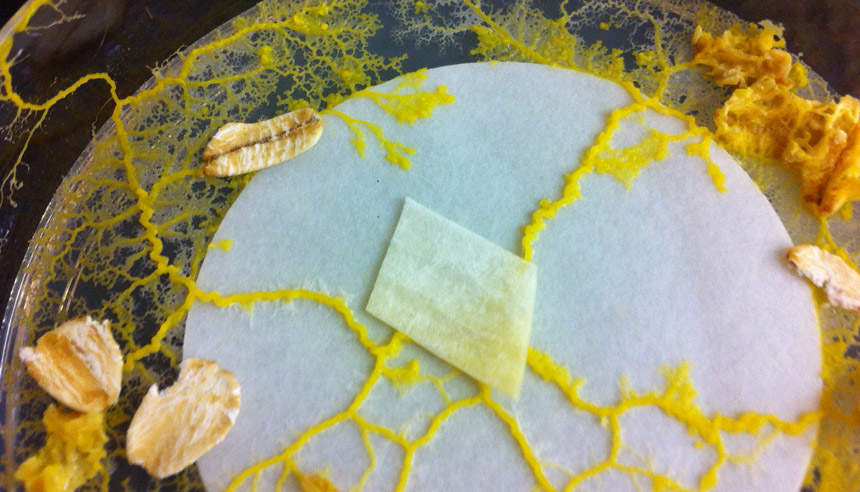High school student studies slime mold smarts
ISEF finalist learns more about the single-celled blob’s simple behaviors

A slime mold may be only a single cell, but it can learn. Hannah McShea studied slime molds to learn more about how they behave.
H. McShea
LOS ANGELES – It’s small, yellowish, and looks like scrambled eggs. It knows where it’s going, and remembers where it has been. It can run mazes and mimic the transportation map of the Japanese city of Tokyo. It’s the slime mold Physarum polycephalum.
Hannah McShea, 18, became interested in slime molds over two years ago. “I found an article on Science News,” recalls the senior at the North Carolina School of Science and Mathematics in Durham. “The scientists were working with a slime mold. It leaves a trail as it moves, and the scientists found that the slime mold won’t cross a trail of its own slime.” The teen was impressed by just how “smart” this slime mold was. “It’s such a simple organism,” she says. “It’s a single cell with all these little nuclei!”
Hannah wanted to use the slime mold to learn more about intelligence. She did tests showing that not only does the critter know where it has been, it can also recognize patterns. She presented her results at the 2014 International Science and Engineering Fair. The annual event, run by the Society for Science & the Public and sponsored by Intel, brings together students from across the globe to show off their science projects. (SSP also publishes Science News for Students and this blog).
Hannah wanted to learn when a slime mold avoids its own trail. “Will it always avoid it? What if there is food on the other side?” she says. She also wanted to know what the slime mold would do if it had to cross its own trail, and if it could process patterns in the world around it.
The teen took her slime mold and set it in a petri dish with some oats, a favorite slime mold food. She put the oats out in a pattern, and let the slime mold spread out and eat them all. Then she placed new oats in the dish. The catch: the slime mold would have to cross its own trail to get to the tasty morsel.
Sadly, the slime mold didn’t get the trick. It wouldn’t cross its own trail, even if there were oats on the other side. “I was thinking the food incentive would be a logical override,” she says, “but I guess it’s just a very simple behavior.” Next, Hannah performed an experiment where the slime mold had no choice — it had to cross its own trail. When placed in such a dilemma, the slime mold slid into its own tracks and followed the old trail, “like a highway system,” she says.
Finally, the teen wanted to see if the slime mold could follow a pattern. Previous studies with these creatures have shown that they can “tell time” in a very basic way. Hannah explains that “if you provide a stimulus every hour for five hours, such as making it retreat from cold, and then you don’t on the sixth hour, the slime mold will still respond at the right time.” She wondered if this behavior extended to patterns in space.
The teen took two slime molds in their dishes. They both received a predictable trail of oats to follow. But the first slime mold stopped receiving oats halfway, while the other continued on its tasty path. Under these conditions, Hannah showed that the slime mold without the oats continued on the same trail, expecting the oat pattern to continue.
“The slime mold is the simplest model of intelligence that we’ve got,” Hannah says. “It could help us understand more complex systems like the human brain.” Her research tells scientists more about what slime molds can and can’t do, and may make us ask ourselves what it really means to be “smart.”
Follow Eureka! Lab on Twitter
Power Words
intelligence The ability to collect and apply knowledge and skills.
slime mold A simple organism that consists of a single cell of creeping, jellylike protoplasm containing nuclei. It is not a mold, despite its name; it isn’t even closely related to fungi.